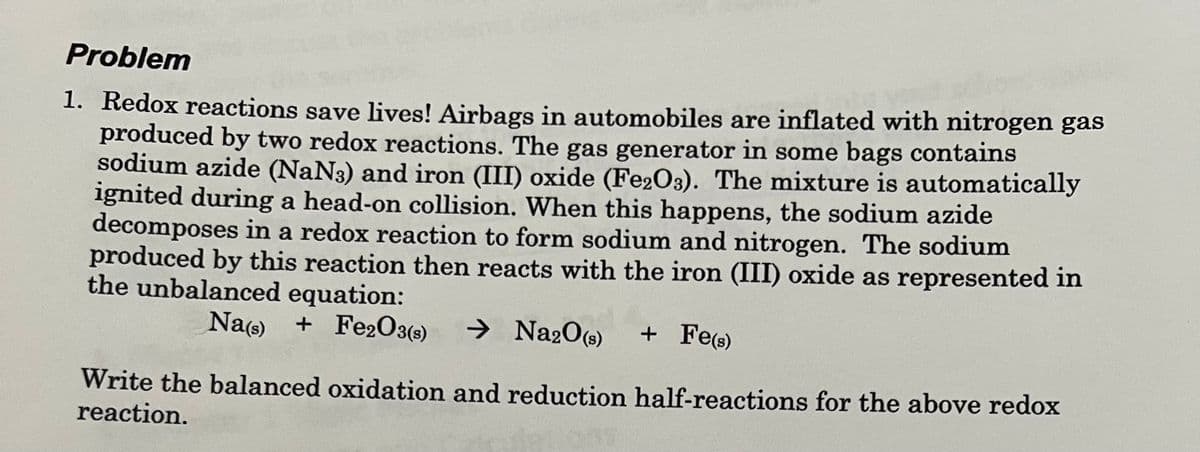Problem 1. Redox reactions save lives! Airbags in automobiles are inflated with nitrogen gas produced by two redox reactions. The gas generator in some bags contains sodium azide (NaN3) and iron (III) oxide (Fe2O3). The mixture is automatically ignited during a head-on collision. When this happens, the sodium azide decomposes in a redox reaction to form sodium and nitrogen. The sodium produced by this reaction then reacts with the iron (III) oxide as represented in the unbalanced equation: Na(s) + Fe2O3(s) → Na2O(s) + Fe(s) Write the balanced oxidation and reduction half-reactions for the above redox reaction.
Problem 1. Redox reactions save lives! Airbags in automobiles are inflated with nitrogen gas produced by two redox reactions. The gas generator in some bags contains sodium azide (NaN3) and iron (III) oxide (Fe2O3). The mixture is automatically ignited during a head-on collision. When this happens, the sodium azide decomposes in a redox reaction to form sodium and nitrogen. The sodium produced by this reaction then reacts with the iron (III) oxide as represented in the unbalanced equation: Na(s) + Fe2O3(s) → Na2O(s) + Fe(s) Write the balanced oxidation and reduction half-reactions for the above redox reaction.
Chemistry
10th Edition
ISBN:9781305957404
Author:Steven S. Zumdahl, Susan A. Zumdahl, Donald J. DeCoste
Publisher:Steven S. Zumdahl, Susan A. Zumdahl, Donald J. DeCoste
Chapter1: Chemical Foundations
Section: Chapter Questions
Problem 1RQ: Define and explain the differences between the following terms. a. law and theory b. theory and...
Related questions
Question
100%

Transcribed Image Text:Problem
1. Redox reactions save lives! Airbags in automobiles are inflated with nitrogen gas
produced by two redox reactions. The gas generator in some bags contains
sodium azide (NaN3) and iron (III) oxide (Fe2O3). The mixture is automatically
ignited during a head-on collision. When this happens, the sodium azide
decomposes in a redox reaction to form sodium and nitrogen. The sodium
produced by this reaction then reacts with the iron (III) oxide as represented in
the unbalanced equation:
Na(s) + Fe2O3(s) → Na2O(S)
+ Fe(s)
Write the balanced oxidation and reduction half-reactions for the above redox
reaction.
Expert Solution
This question has been solved!
Explore an expertly crafted, step-by-step solution for a thorough understanding of key concepts.
This is a popular solution!
Trending now
This is a popular solution!
Step by step
Solved in 2 steps with 2 images

Knowledge Booster
Learn more about
Need a deep-dive on the concept behind this application? Look no further. Learn more about this topic, chemistry and related others by exploring similar questions and additional content below.Recommended textbooks for you

Chemistry
Chemistry
ISBN:
9781305957404
Author:
Steven S. Zumdahl, Susan A. Zumdahl, Donald J. DeCoste
Publisher:
Cengage Learning

Chemistry
Chemistry
ISBN:
9781259911156
Author:
Raymond Chang Dr., Jason Overby Professor
Publisher:
McGraw-Hill Education

Principles of Instrumental Analysis
Chemistry
ISBN:
9781305577213
Author:
Douglas A. Skoog, F. James Holler, Stanley R. Crouch
Publisher:
Cengage Learning

Chemistry
Chemistry
ISBN:
9781305957404
Author:
Steven S. Zumdahl, Susan A. Zumdahl, Donald J. DeCoste
Publisher:
Cengage Learning

Chemistry
Chemistry
ISBN:
9781259911156
Author:
Raymond Chang Dr., Jason Overby Professor
Publisher:
McGraw-Hill Education

Principles of Instrumental Analysis
Chemistry
ISBN:
9781305577213
Author:
Douglas A. Skoog, F. James Holler, Stanley R. Crouch
Publisher:
Cengage Learning

Organic Chemistry
Chemistry
ISBN:
9780078021558
Author:
Janice Gorzynski Smith Dr.
Publisher:
McGraw-Hill Education

Chemistry: Principles and Reactions
Chemistry
ISBN:
9781305079373
Author:
William L. Masterton, Cecile N. Hurley
Publisher:
Cengage Learning

Elementary Principles of Chemical Processes, Bind…
Chemistry
ISBN:
9781118431221
Author:
Richard M. Felder, Ronald W. Rousseau, Lisa G. Bullard
Publisher:
WILEY